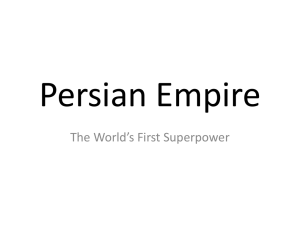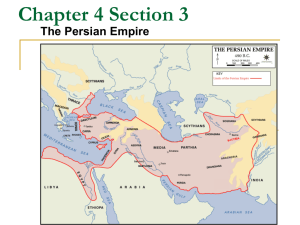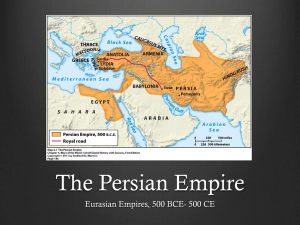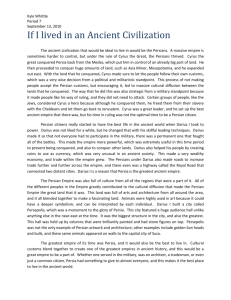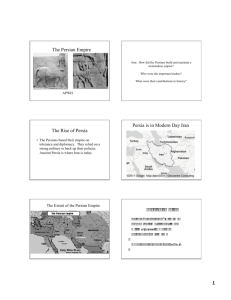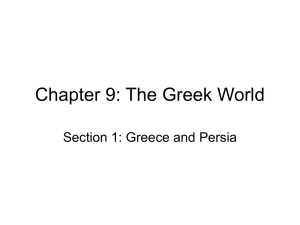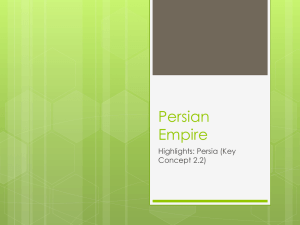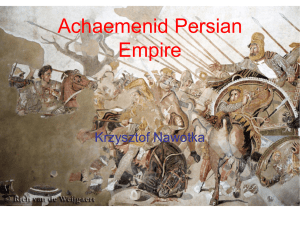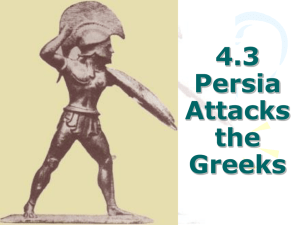Persian Empire
advertisement
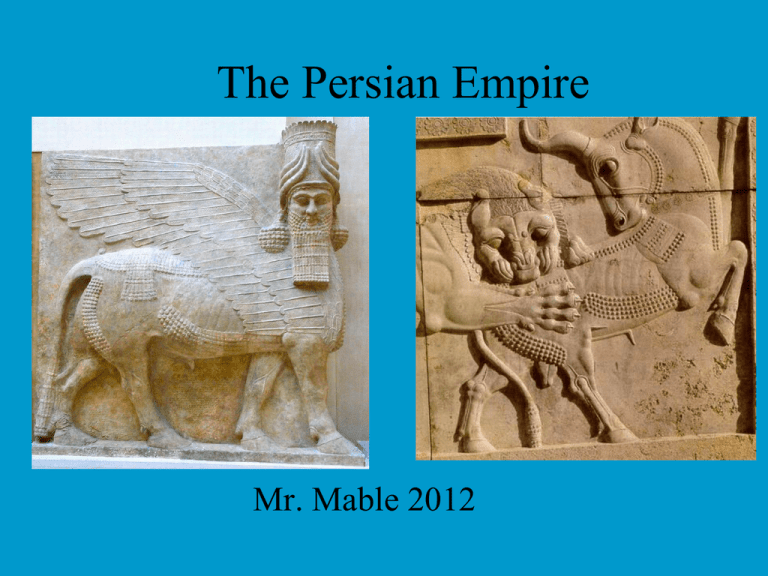
The Persian Empire Mr. Mable 2012 Aim: How did the Persians build and maintain a tremendous empire? Who were the important leaders? What were their contributions to history? The Rise of Persia • The Persians based their empire on tolerance and diplomacy. They relied on a strong military to back up their policies. Ancient Persia is where Iran is today. Persia is in Modern Day Iran The Extent of the Persian Empire Cyrus the Great Cyrus’s Empire • 550 BC – Conquered several neighboring kingdoms • Military genius • Controlled an empire spanning 2000 miles • Kindness toward conquered people • Honored local customs and religions • 538 BC - Allowed the Jews to return to their homeland, Jerusalem • Considered by the Jews to be one of God’s anointed ones Tolerance !!! • Cyrus use the idea of tolerance to keep the peace and to seem like a liberator. • He allowed people to keep their local customs and religions. • He showed kindness toward conquered peoples Primary Source • “This is the word of Cyrus king of Persia: The Lord, God of heaven has given me all the kingdoms of the earth, and he himself has charged me to build him a house at Jerusalem in Judah. To every man of his people now among you I say, God be with him, and let him go up to Jerusalem in Judah, and rebuild the house of the Lord God of Israel, the God whose city is Jerusalem.” • What type of ruler was Cyrus based on this quote? PERSIA and the city of PERSEPOLIS PERSEPOLIS • 518 BCE • King Darius utilized influences and materials from all over his empire, which included Babylon, Egypt, Mesopotamian and Greece PERSEPOLIS • At the height of the Persian Empire it stretched from India to Africa • Persia today is known as Iran • The city included extensive use of columns VOCABULARY WORDS • The COLUMN is divided into three parts: • The BASE • The SHAFT • The CAPITAL • This shaft is FLUTED PERSEPOLIS • Dauris was followed by his son, Xerxes (ruled 485-465) • The Apadana (Audience Hall) features wonderful low relief sculpture Persian Art Persepolis, Iran • Apadana with huge columns 60 feet tall • 36 columns with bull-shaped tops • Reliefs on walls symbolize Persian guards called Immortals • 10,000 Immortals protected the city and ruler • Large ramps leading to apadana enable chariots to enter hall 17 Zoroastrianism • Persian Religion • Monotheism • Good went to Heaven • Bad went to Hell How did Cyrus and Darius keep control of such a vast empire? • Broke Empire down into provinces • Royal Governors = Satraps • They were loyal to the Emperor and did his bidding. Satraps Royal Spies • They spied on the citizens and on the governors to make sure they were not going to steal or revolt. Persian Empire, 500 BC The Royal Road • 1,677 miles long with 111 relay stations • Other smaller roads branched off the royal road • Relay stations had rest areas and fresh horses. • The entire royal road could be traveled in a week by a horsemen • Caravans took about a month How would the royal road enable a ruler to maintain power in the empire? Darius Darius the Great • Member of the king’s body guard • Overthrew the king in 522 BC • Took power and created a well-organized efficient government • Brought peace and stability • Expanded the empire by 500 miles • But could not conquer Greece First Persian War Battle of Marathon The Athenians had won at Marathon but they certainly had not destroyed the Persian army. They had made plans before the battle that if they won, they would get word back to Athens as soon as possible because they knew that the Persian fleet was sure to sail around Attica and attempt to take the city while it was undefended. The citizens were to man the walls and make it appear that Athens was strongly defended. Marathon part 1 Marathon part 2 Marathon Phaedippas Miltiades sent a young soldier (probably Phaedippas) to take word back to Athens. He ran the entire distance, 42.192 kms, shouted "We have won!" and fell dead of exhaustion. In memory of this event the Marathon Run was included among the contests since the first contemporary Olympic Games. Result of the 1st Persian War Darius Lost! Persia Continued to lose its power to expand Xerxes • Became a Dictator • Did not follow Darius or Cyrus and was not tolerant • Wanted to conquer Greece at all cost Second Persian War Battle of Thermopylae • It means the “HOT GATES” • 300 Spartans held off 1 million troops of the Persian Empire • Was really a delaying action to stall the Persians so that Athens could be evacuated. • Tactical advantage because of choke point in the terrain. Thermopylae The Immortals • Xerxes’s best troops in the Persian army. • Supposed to be invincible. • Spartans proved othewise. The Persians eventually Broke Through • After killing the 300 Spartans the Persians Marched on Athens • Athens was deserted; evacuated to the Island of Salamis • The Athenians forced a naval battle in the Bay of Salamis Greek Trireme Battle of Salamis Battle of Salamis • Persians were bottlenecked in the small bay of Salamis • They could not maneuver • The smaller Greek Ships destroyed the Persian fleet. Result of the 2nd Persian War Xerxes Lost! Persia had to retreat home in failure. Never again did Persia expand. Alexander the Great • Macedonian (Greek) King that laid the final death blow to the Persian Empire and conquered it. Where is Greece? Where is Macedonia? Greece? In November 333, Alexander the Great and his trusted general Parmenion defeated the Persian king Darius III Codomannus on the uneven coastal plain south of Issus.
